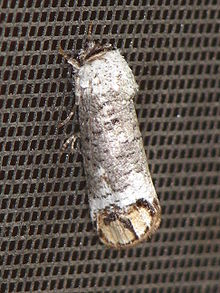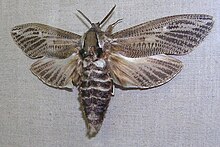Cossidae
| Cossidae | |
|---|---|

| |
| Cossula magnifica(Cossulinae) | |
| Scientific classification | |
| Domain: | Eukaryota |
| Kingdom: | Animalia |
| Phylum: | Arthropoda |
| Class: | Insecta |
| Order: | Lepidoptera |
| Infraorder: | Heteroneura |
| Clade: | Eulepidoptera |
| Clade: | Ditrysia |
| Clade: | Apoditrysia |
| Superfamily: | Cossoidea |
| Family: | Cossidae Leach, 1815 |
TheCossidae,thecossid millersorcarpenter millers,make up afamilyof mostly largemiller moths.This family contains over 110 genera with almost 700 known species, and many more species await description. Carpenter millers areLepidopterafound worldwide, They arenocturnal,except for theSoutheast AsiansubfamilyRatardinae.

This family includes many species with largecaterpillarsandmothswith awingspanfrom9–24 cm (3+1⁄2–9+1⁄2in).[citation needed]These moths are mostly grey; some have long, narrow wings and resemblehawkmoths(Sphingidae) which are more advancedmacrolepidoptera,however. Many are twig, bark, or leafmimics,and Cossidae often have some sort of large marking at the tip of the forewing uppersides, conspicuous in flight, but resembling a broken-off twig when the animals are resting.
Caterpillars are smooth with a few hairs.[1]Most cossid caterpillars are tree borers, in some species taking up to three years to mature. The caterpillarspupatewithin their tunnels; they often have an unpleasant smell, hence another colloquial name isgoat moths.
The family includes the carpenterworm (Prionoxystus robiniae) and thegoat moth(Cossus cossus) which have gained popularity aspests.However, the large caterpillars of species that do not smell badly are oftenedible.Witchetty grubs– among theOutback's most famousbush tucker– are most commonly the caterpillars ofEndoxyla leucomochla,one of the more than 80 cossid species inAustralia.InChile,the sweet-smelling caterpillars of the Chilean moth (Chilecomadia moorei) are harvested in quantity and internationally traded as butterworms, for use aspet foodandfishing bait.
Systematics
[edit]Some other animal families, such as theDudgeoneidae,Metarbelidae,and Ratardidae, have been included within this family time and again. The first is considered a distinct family of theCossoideatoday recognizable by theirabdominaltympanal organswhich the Cossidae lack, whereas the other two are usually kept in the Cossidae assubfamilies.Some unrelated millers were included in the Cossidae in error, too, such as the genusHolcoceroideswhich is more primitiveDitrysia,or theAndesianidaewhich are even more ancientHeteroneura.
The Cossidae were usually divided into sixsubfamilies.[2]However, numerous newsubfamilieshave been described recently, the current taxonomy is:

- SubfamilyCatoptinae
- SubfamilyChilecomadiinae
- SubfamilyCossinae
- SubfamilyCossulinae
- SubfamilyHypoptinae
- SubfamilyMehariinae
- SubfamilyMetarbelinae(disputed)
- SubfamilyPolitzariellinae
- SubfamilyPseudocossinae
- SubfamilyRatardinae(disputed)
- SubfamilyStygiinae
- SubfamilyZeuzerinae

- GeneraIncertae sedis:
Excluded genera
[edit]- Moth genera now included inDudgeoneidae
- Moth genera now included inPsychidae
- Other
References
[edit]- ^Hampson, G. F.(1892).The Fauna of British India, Including Ceylon and Burma: Moths Volume I.Taylor and Francis.Archivedfrom the original on 2017-09-30.Retrieved2018-01-14– via Biodiversity Heritage Library.
- ^Pitkin & Jenkins (2004) and see references in Savela (2006)
Further reading
[edit]- Pitkin, Brian & Jenkins, Paul."Search results Family: Cossidae".Butterflies and Moths of the World.Natural History Museum, London.RetrievedFebruary 28,2009.
- Savela, Markku."Cossidae Leach, 1815".Lepidoptera and Some Other Life Forms.RetrievedNovember 18,2018.
External links
[edit]- FlickrCossidae
